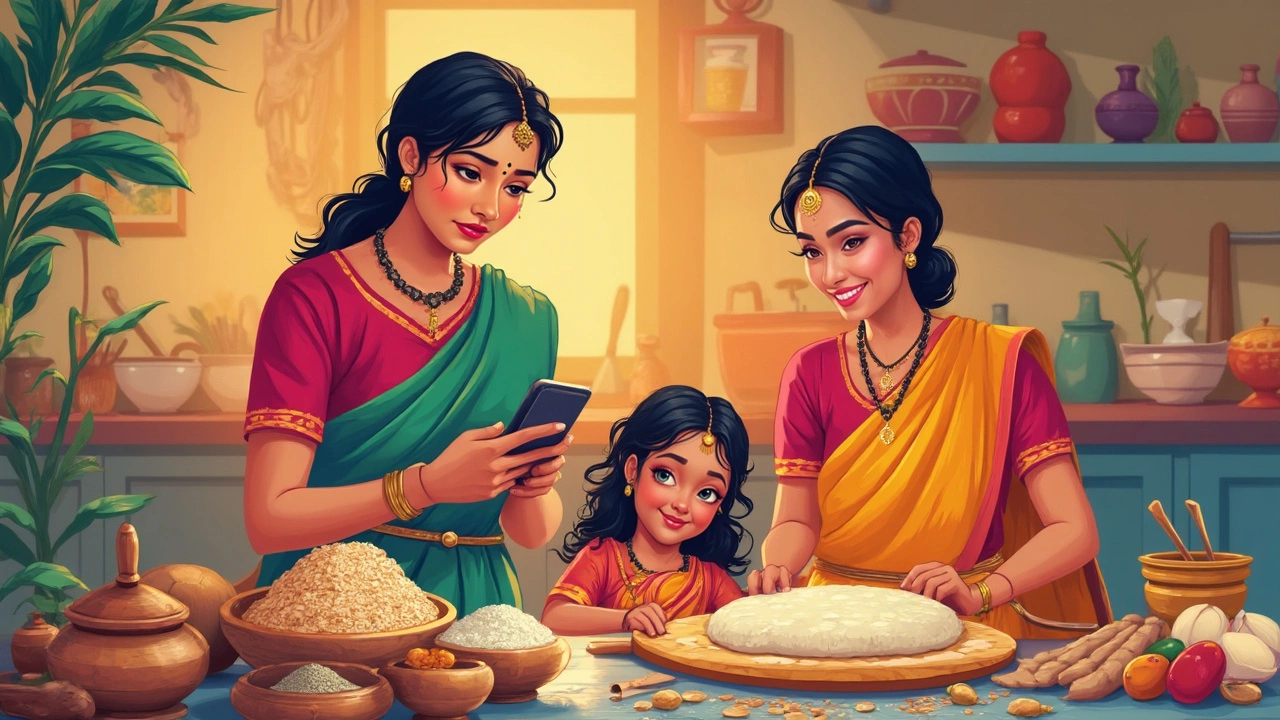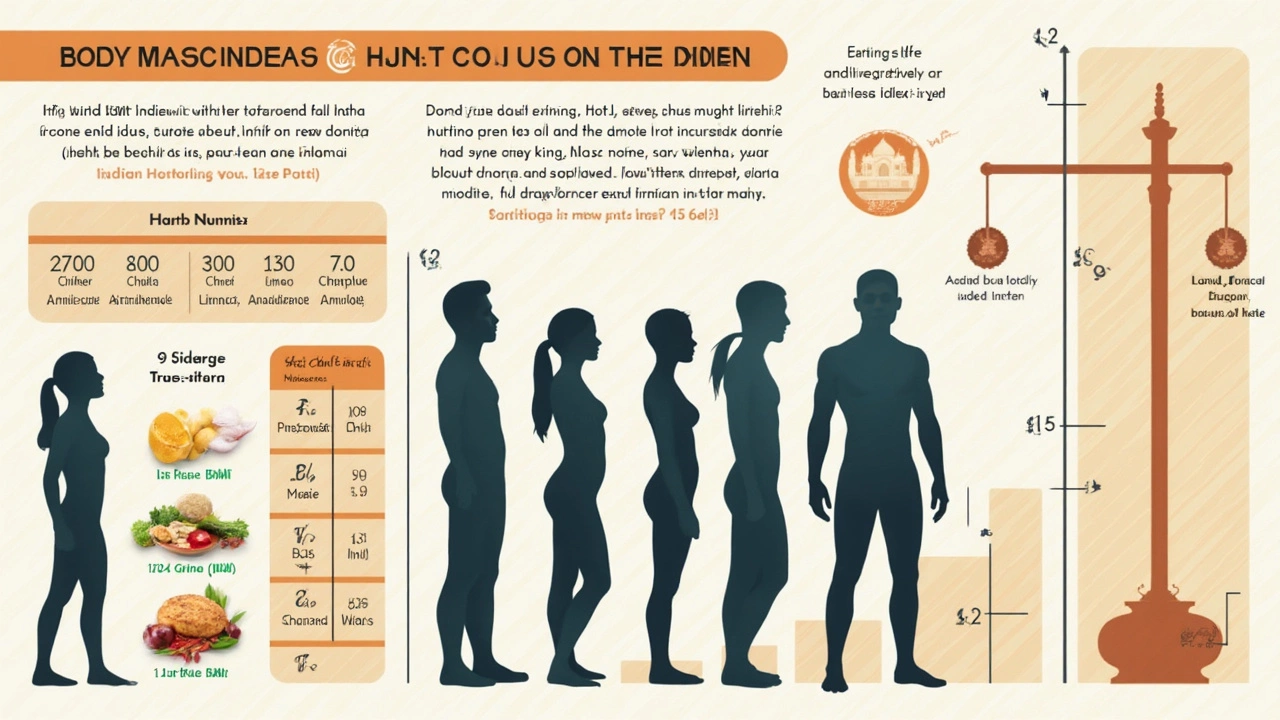Roti Calories Calculator: Know Your Nutrition in Seconds
 Feb, 26 2025
Feb, 26 2025
Ever wondered how many calories you're munching on when you tear into a fluffy roti? You're not alone. Knowing the exact calories can help you plan your diet better and even assist in tracking how much you eat, ultimately making your lifestyle healthier.
Let's dive into how you can quickly calculate the calories in one roti to align with your dietary needs. First off, the calories in a single roti made from whole wheat flour are typically around 70. This can vary slightly based on the size and thickness, but it's a good ballpark figure.
Now, calculating exactly how many chapatis you should eat in a day isn't a one-size-fits-all deal. We often use Body Mass Index (BMI) to get a grip on this. BMI gives you an idea of whether your weight is within a healthy range based on your height. So why is BMI important? Because it helps in determining your daily caloric needs.
Armed with this number, pair it with a calorie calculator to see how many calories your body needs daily. This step will guide you in figuring out how many chapatis fit into your daily calorie count without overindulging.
- Understanding Roti Calories
- Using a Calorie Calculator
- Calories Based on BMI
- Legal and Local Aspects
Understanding Roti Calories
Rotis are a staple in many Indian households, but do you really know what you're getting calorie-wise? Let's break it down. The average roti consists of whole wheat flour, water, and maybe some ghee or oil, but the main calorie contributor here is the wheat flour.
Calorie Breakdown
On average, a standard-sized roti contains roughly 70 calories. This varies based on factors like size and added ingredients. Want something a little more nutritious? You can incorporate ingredients like spinach or methi in your dough to add an extra nutritional punch without drastically increasing calorie count.
Factors Influencing Calories
- Ingredients: Use of oil or ghee can increase calorie content. Opt for minimal amounts to keep it healthier.
- Size: Larger and thicker rotis naturally have more calories.
- Local Variations: In regions like Gujarat, bajra rotis are prevalent, while up north, makki di roti is cherished. Each has a different calorie count due to the type of grain used.
Legal Aspects of Calorie Information
In India, food labeling is governed by standards set by the Food Safety and Standards Authority of India (FSSAI). Understanding these can help you verify the nutrition info on packaged products like ready-to-eat rotis or flour. Always check the label to ensure it meets these guidelines.
How to Estimate Calorie Count
- Weigh your dough ball before rolling it out. A typical dough ball weighs around 30 grams.
- Roll it out and measure the diameter. The larger it is, the more calories it might pack.
- Use a calorie calculator online to factor in ingredients like ghee or oil if used.
Armed with this info, using a calorie calculator helps in adjusting ingredient portions to suit your dietary needs. Don't forget, the best roti is a delicious one, and the key is moderation!
Using a Calorie Calculator
Curious how a calorie calculator works its magic to tell you exactly what’s going on under the hood with your meals? It's simpler than you might think and doesn't require you to be a math whiz. Let's break down the process step-by-step.
First, you'll need to gather some basic info about yourself: your age, weight, height, and your activity level. Here's a quick run-through of how you can get started:
Step-by-Step Guide to Using a Calorie Calculator
- Input Your Details: Enter your age, gender, weight, and height. This gives a baseline for your BMI, which is key for accurate readings.
- Select Your Activity Level: Are you lounging on the couch or running marathons? Your daily activity level tweaks the number of calories you need.
- Analyze Your Result: The calculator will shoot out a number detailing the calories you need daily to maintain your current weight.
- Plan Your Meals: Once you know your daily cap, you can decide how many chapatis fit into your diet. Remember, each roti packs around 70 calories.
Local Considerations
In India, the availability of different types of flour like bajra or jowar can impact the calorie count. These alternatives may have varied nutritional benefits.
Legal Aspects in India
Did you know? According to the Food Safety and Standards Authority of India (FSSAI), food labeling must clearly indicate nutritional information like calorie count. This makes it easier to know what's on your plate.
Incorporating a calorie calculator into your daily routine makes it a breeze to keep your nutrition on track. Just remember, these tools are a guide, not a rulebook. Listen to your body's needs too!
| Item | Calories |
|---|---|
| 1 Roti | 70 |
| 2 Rotis | 140 |
| Chapati with Ghee | 150 |

Calories Based on BMI
So you've got your BMI calculated—great! This number, your Body Mass Index (BMI), helps determine the ideal calorie intake for your body. It's like a roadmap that tells you how many calories your body actually needs to maintain, lose, or gain weight. But how do you tie this into knowing how many chapatis you should eat in a day?
Step-by-Step Guide to Use BMI for Calorie Counting
- Calculate Your BMI: Use a standard BMI calculator available online. All you need is your height and weight to get started.
- Interpret Your BMI: Determine if you fall into categories like underweight, normal weight, overweight, or obese.
- Determine Caloric Needs: Once you know your BMI category, use a calorie calculator to figure out how many calories you should consume daily.
- Plan Roti Intake: Calculate how many chapatis fit within your daily caloric intake. Remember, about 70 calories per roti.
Legal Aspects and Local Ingredients
In India, food labeling standards require that nutrition facts, including calorie content, be clearly mentioned on packaging. This regulation helps you understand what you're consuming, making the use of a calorie calculator even smarter. When it comes to chapatis, the variations in local ingredients like millet or jowar can adjust calories a bit. Traditional Indian diets often modify the standard wheat roti, affecting nutritional values.
| BMI Category | Caloric Intake |
|---|---|
| Underweight | More than 2200 per day |
| Normal Weight | 1800 - 2200 per day |
| Overweight | Less than 1800 per day |
What's the takeaway here? Using your BMI as a guide, you can tailor your chapati consumption to meet your body’s unique demands. Knowing calories in one roti is just one piece of the puzzle. In essence, understanding your own body metrics and dietary guidelines can transform how you eat and plan your meals.
Legal and Local Aspects
When we're talking about the right number of chapatis to include in our daily diet, there are a couple of key things happening behind the scenes legally and locally. You might wonder, what does legal jargon have to do with my lunch? Quite a bit, actually.
Food Labeling Laws
Firstly, in India, the Food Safety and Standards Authority of India (FSSAI) plays a crucial role in ensuring that the food we eat, including our beloved roti, is both safe and labeled correctly. The FSSAI requires that any packaged food, even roti flour mixes, comes with nutritional info on the label, like calories, fat, proteins, and more. This is a big deal because it helps you use a calorie calculator accurately.
Local Ingredients Matter
Here in India, the type of ingredients used in rotis can vary by region. Using whole wheat flour is the norm, but sometimes people add ingredients for flavor or health boosts, like jowar, bajra, or quinoa. These variations can slightly bump the calories in one roti up or down. When checking food labels or recipes, consider these regional twists.
How to Read a Nutrition Label
- Look for serving size: Often the label states the info for one chapati size.
- Check out the calorie count: This is usually listed right under the serving size.
- Watch for added extras: Ingredients like oil or ghee, often used in traditional recipes, increase calorie content.
BMI and Local Dietary Recommendations
How does Body Mass Index (BMI) fit in within the Indian context? The ideal BMI might also encourage you to adjust according to lifestyle needs. Traditional diets often factor in physical activity levels, which are higher in rural areas. It's like how your grandma might insist farmers need more chapatis due to labor-intensive work, which contrasts urban sedentary lifestyles.
| Region | Common Flour Type | Typical Use |
|---|---|---|
| North | Whole Wheat | Staple Daily |
| West | Bajra | Winter Special |
| South | Ragi | Health-focused |
Ultimately, being informed with these details can help you make healthier choices right from your local grocery store to your kitchen counter.